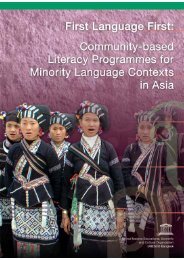Part II.pdf - MTB-MLE Network
Part II.pdf - MTB-MLE Network
Part II.pdf - MTB-MLE Network
You also want an ePaper? Increase the reach of your titles
YUMPU automatically turns print PDFs into web optimized ePapers that Google loves.
literacy, this project was targeted at preservation of the language. A language can be preserved<br />
only if it is used by the people. To use a language, one has to learn it.<br />
During the course of the literacy campaign in Assam, it was observed that many illiterate people<br />
were not coming forward to take part in the exercise. SRC Assam has to date produced reading<br />
materials in Assamese, Bengali and Boro based on its participation in a workshop organized by<br />
UNESCO on minority language material production, on research and on country experience. SIL<br />
International was one of the participants.<br />
There are many such minority language groups in Assam. SRC Assam has, therefore, decided to<br />
prepare materials in a phased manner for these indigenous language groups in effort to eradicate<br />
illiteracy.<br />
SRC Assam has already taken up materials development in the Rabha language for propagation of<br />
literacy in the state. Our experience has shown us that literacy is successful when the community<br />
is a stakeholder in the campaign. This comes from a spirit of voluntarism and the community taking<br />
ownership of the campaign. The present initiative is a step in this direction. The workshop will<br />
be a success when the participants involve themselves in the literacy campaign. SIL International<br />
and Gauhati University have also offered their academic support.<br />
Community mobilization<br />
The State Resource Centre has involved the<br />
community in the research and field study.<br />
There have been awareness meetings, and local<br />
interaction with government officials and<br />
school teachers.<br />
Learning needs<br />
There are nearly 200 spoken languages in the<br />
northeast, some of which do not have a script of their own. In such cases, they have adopted<br />
Devanagari, Roman or Assamese as their written script. Only a few languages, like Assamese and<br />
Bengali, have their own script.<br />
As there are many minority language groups in Assam without any reading materials in their language,<br />
the SRC has decided to prepare materials in a phased manner for the minority language groups.<br />
For the first project, the SRC has taken up the development of material in the Rabha language. In<br />
this project, entitled “Action Research on Literacy through Indigenous Language,” SIL International<br />
came forward to offer their academic support.<br />
Developing writing systems<br />
Since the language spoken by the Rabhas does not have a script of its own, any material production<br />
will have to be done in some other script. The Rabha Literacy Society has also unanimously decided<br />
to accept the Assamese script for the development of books. This is due to the fact that most of<br />
175
















